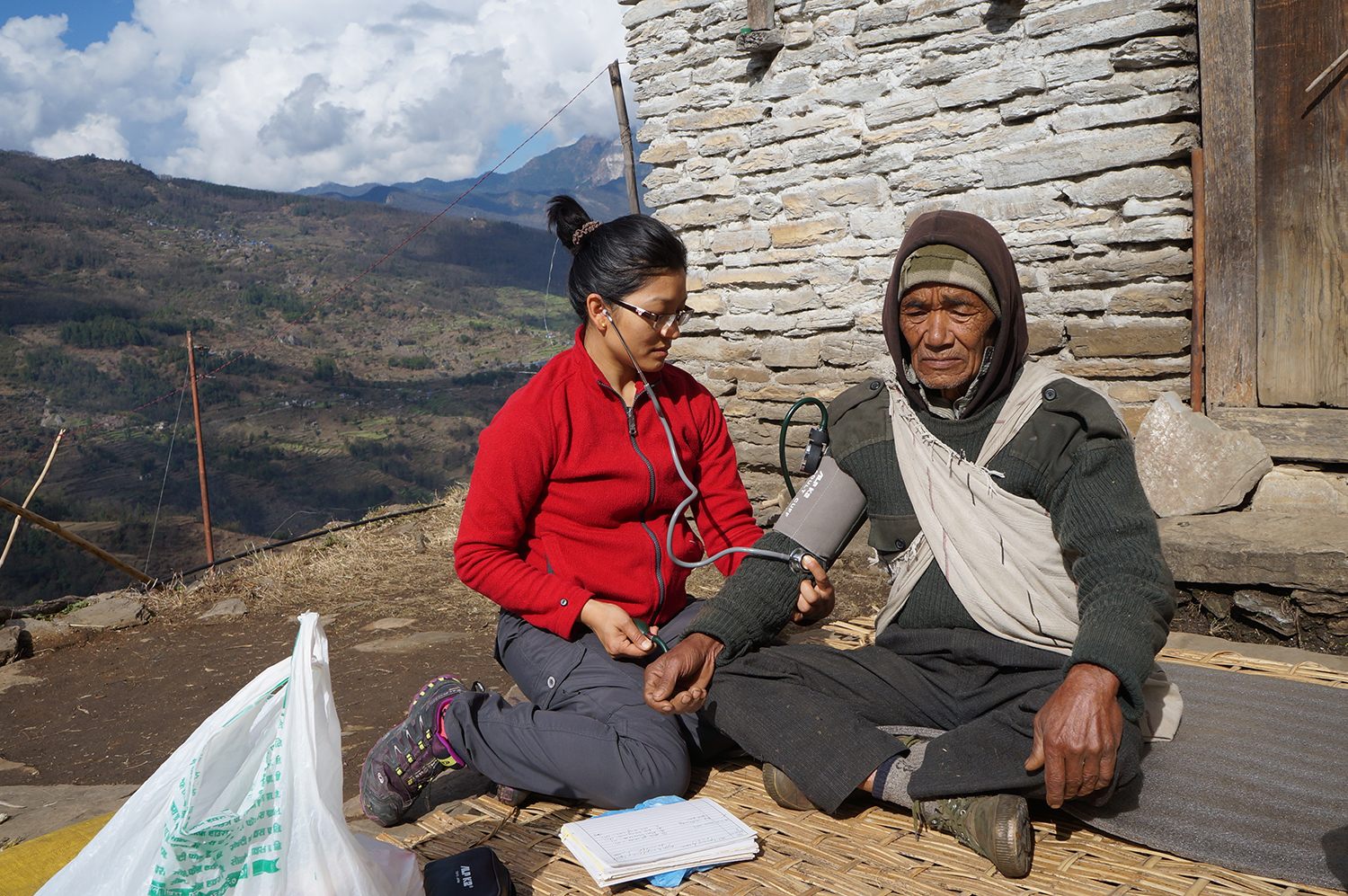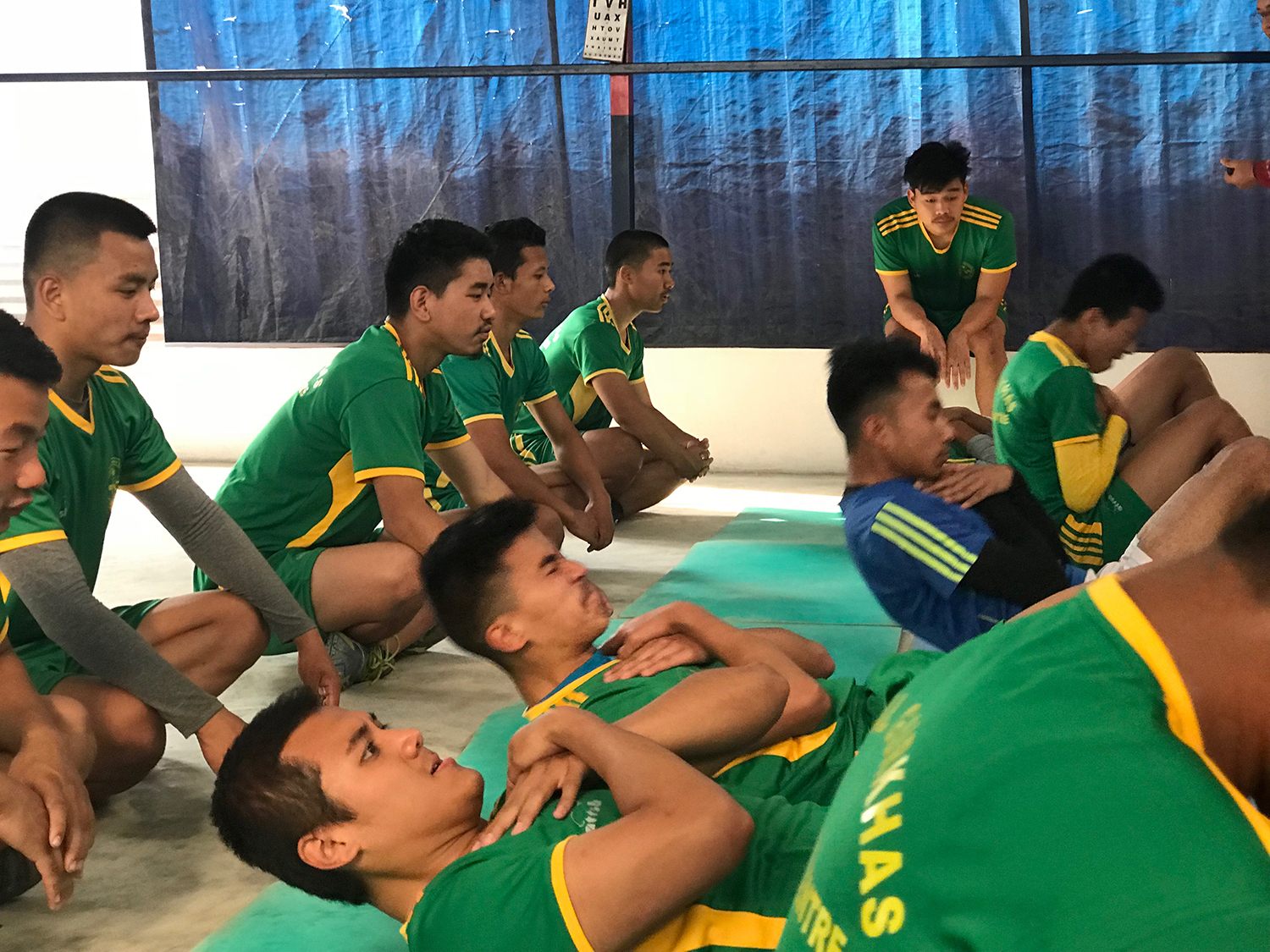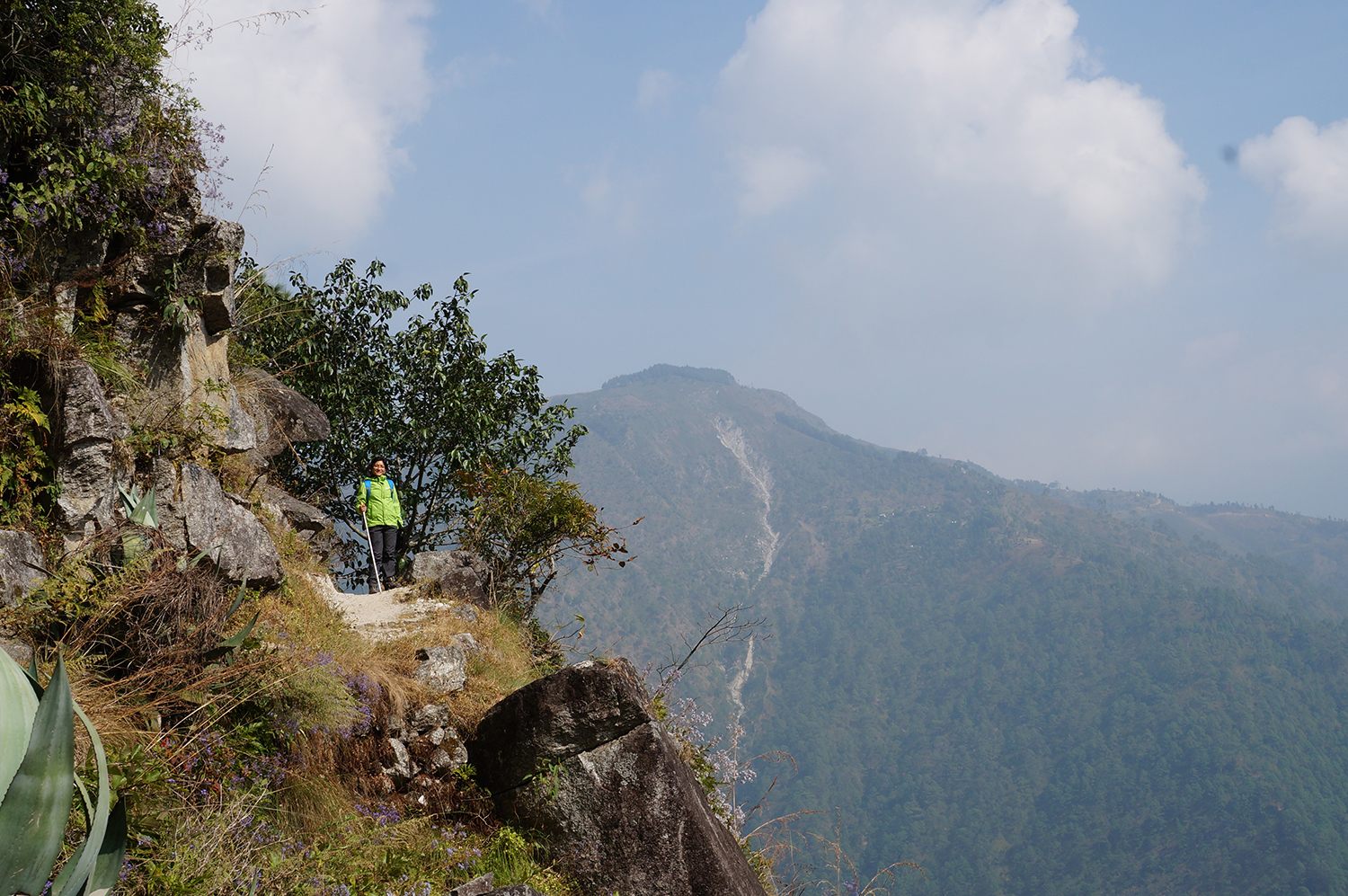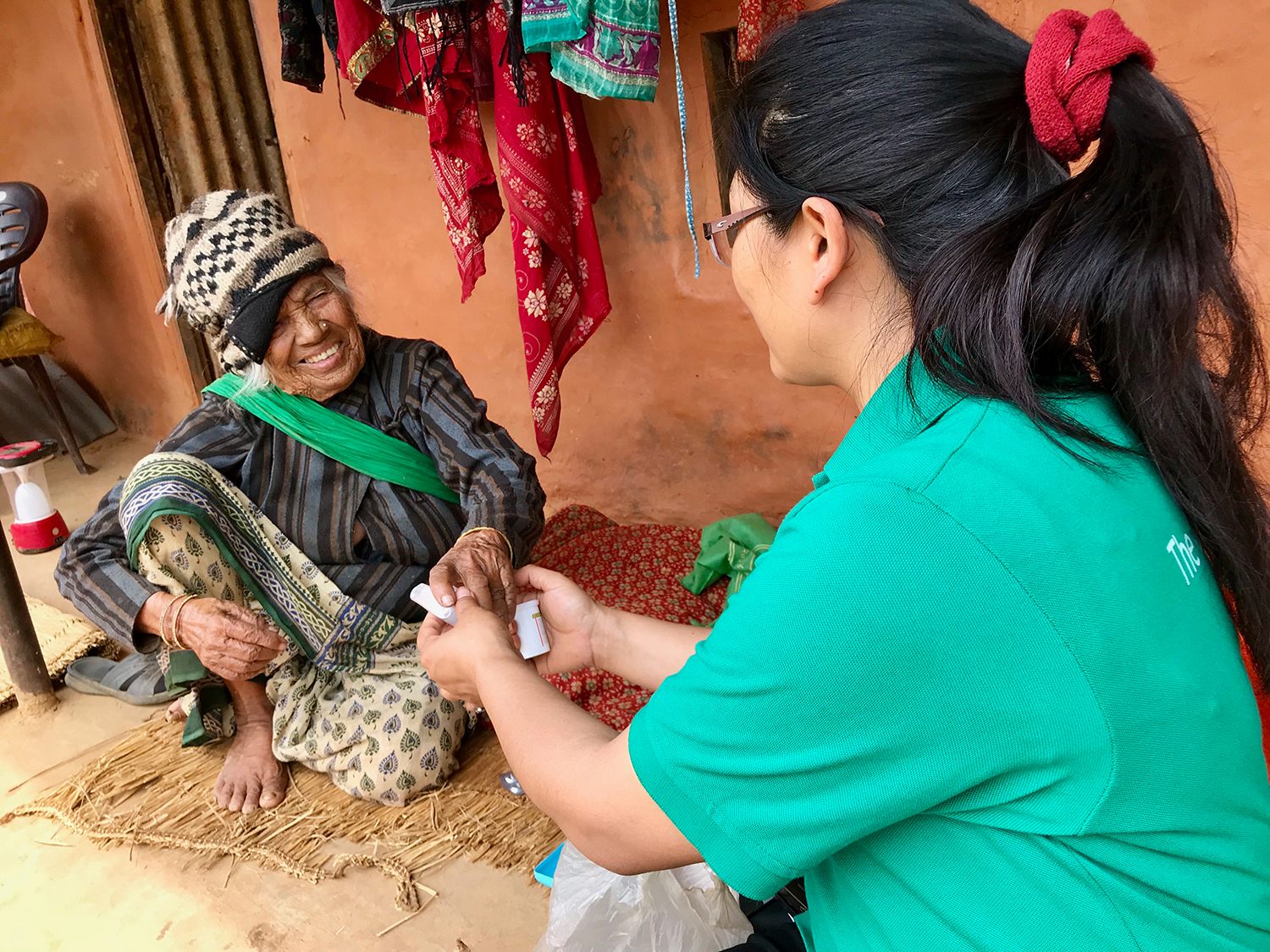The Doctor Making House Calls in the Himalayas
Dr. Sobi Maya Tamang makes the trek to care for aging Gurkhas, a group of Nepali soldiers recruited by the British Army.

On an early Monday morning in April, in a Kathmandu valley suburb, a dozen young men dressed in green gym shorts and jerseys are sweating through the last round of sit-ups. The branding on their backs—“Royal Gurkhas Training Centre”—is all that sets them apart from countless morning workouts around the globe. Their goal is to compete against approximately 10,000 other Nepalese men for just around 250 openings in the British Army’s Gurkha units, a tradition with a 200-year history.
“Most of them are from poor families; they come from villages,” says Urgendra Lama, a teacher at Lotus Training Institute, a popular Gurkha training center in Pokhara, central Nepal. Lama teaches the boys English, math, and interview skills, all part of the British Army’s annual selection process.
Others are following in the footsteps of their fathers and grandfathers, and those Gurkhas before them who have served in nearly every British war over the past two centuries.

When Britain’s East India Company and Nepal’s army fought over territory in 1815, the Europeans were so impressed with the courage and discipline displayed by the men of the Himalayas, they began to recruit the so-called “martial race,” a colonial designation for ethnicities with warrior-like qualities. To this day, the Brigade of Gurkhas—a collective reference that encompasses various Gurkha-staffed units—has the legendary reputation in the U.K. of being elite fighters, and is bestowed with the highest prestige in Nepali society.
There are currently 2,900 Gurkhas in the British military, but at one point, during World War II, there were 120,000. Those who survived Burmese jungles, European winters, and African deserts to return home, found themselves in a bureaucratic battle with a British Army that denied them equal pay and benefits.
Even today, thousands of elderly Gurkha veterans, and their families, depend on charity for basic needs, including pensions and healthcare.

It took a seven-hour bus journey, along winding roads from the capital city of Kathmandu, and a two-hour walk on dirt paths too small for a car, to reach Chandra Kumari’s village, perched on a picturesque hillside in the western Himalayas. Her husband, who had fought for the British in World War II, had died just over a month prior, so now the 93-year-old widow is one of thousands of beneficiaries of the Gurkha Welfare Trust, a British charity set up in 1969 to keep Gurkha veterans and their families from destitution.
Despite the distance, this house call was not terribly daunting for Dr. Sobi Maya Tamang, who is used to trekking for three days along cliffs in the eastern Himalayas to reach a patient. Tamang has been the Trust’s mobile doctor for seven years, visiting Gurkha veterans in some of the world’s most remote areas. That far in the mountains, a walk between one house and the next can take an entire day.
“That’s the life in the village,” says Tamang. “If you have to go to another relative’s house, or if you have to get to a certain place, you have no choice but to walk up and down the hill.” She, like other Nepalis, calls everything short of snow-capped peaks such as Mt. Everest “hills.”

Every three months, the Trust’s beneficiaries collect their pensions from a district office, which also requires days of walking, typically barefoot.
“Even if we give them slippers or shoes, they find it very difficult to wear,” Tamang says of the villagers. “They just carry the shoes and walk barefoot because all their life they have been walking barefoot. If I ask them why don’t they wear the shoes, they say, ‘It’s very uncomfortable for me.’”
The quarterly visits to the district office are also opportunities to report medical problems, and that’s one of the ways Tamang gets notified that she’s needed. Typically, anyone under 90 makes the trek themselves, and if they are too old, or not well, a family member might come in their stead, according to Tamang.
All things considered, Kumari’s village was not far from the town of Gorkha. With some help from neighbors, Tamang swiftly located her patient’s one-room house built from red clay and corrugated iron, and Kumari pulled out woven mats for seating on the cement porch. With neighbors and extended family watching, Tamang checked her patient’s pulse and blood pressure, and listened to the wheezing in her lungs. The woman confessed she didn’t know how to properly use an inhaler she’d been given, and Tamang patiently went through the steps.

In other house visits, the doctor would be welcomed into the home. But despite her hospitality, Kumari didn’t make such an offer.
“She is a Brahmin,” Tamang explains, referring to Kumari’s Hindu caste. Considering her culture and way of life, Tamang concluded the elderly woman likely didn’t want “beef-eaters” in her home, thereby risking bad luck. Dietary practices vary depending on region and culture, and some Brahmin and Hindus are vegetarian, and many don’t eat beef. Tamang, like many Nepalis, incorporates both Buddhist and Hindu practices into her daily life, and says she knew Kumari’s caste by seeing the patient’s name.
Despite being a tiny country of 29 million sandwiched between India and China, specifically the autonomous region of Tibet, Nepal is incredibly diverse. There are more than 100 ethnic groups or castes, as well as languages, in a country half the size, in terms of both population and land area, of the United Kingdom. Tamang regularly comes across patients in remote villages who speak one of over 100 dialects instead of the national Nepali language.
Regardless of this diversity, any Nepali serving in a foreign military or police force—including those in the U.K., India, and Singapore—is called a Gurkha. The Indian Army, which inherited ten Gurkha regiments when India gained independence in 1947, uses the spelling Gorkha. This is in reference to Gorkha, a populous district in the western Himalayas, and a place of significance in Nepal’s history.

Not far from Kumari’s village is Gorkha Durbar, the hilltop palace of Prithvi Narayan Shah, the king who unified rival kingdoms into Nepal in the middle of the 18th century. The kingdom spread from Kashmir to east of Bhutan, and integrated many different peoples.
Gorkha Durbar is now under renovation, three years after a devastating earthquake killed 9,000 people and destroyed much of Nepal. It’s a rare stop for the nearly one million foreigners who visit Nepal each year, but remains a popular destination with domestic tourists, who revere their history.
This is, after all, where the legendary Gurkhas get their name. It was the army, known as the Gorkhali, of the king who ruled from Gorkha that clashed with the world’s largest empire in the Anglo-Nepalese War from 1814 to 1816. During the battle of Kalanga, in one of the numerous near-mythical stories that kicked off the centuries-long relationship between the two militaries, just 600 Gorkhali held a mountain against 4,000 well-armed British troops for a month. The war ended with the signing of the Treaty of Sugauli, which ceded some of Nepal’s territory to British India, and established the U.K.’s right to recruit the warriors who so impressed them in battle.

Tamang, the mobile doctor, grew up hearing her grandfather’s stories about World War II. While her childhood memories are fuzzy, certain details stuck in her mind: the 11 days her grandfather’s captured regiment starved, for example, leading some of the men to attempt to eat bird feces, or the time they needed to figure out which wild plants in the Burmese jungle were edible, by comparing them to vegetation in Nepal.
Tamang’s grandfather returned home a hero and, like so many others, found himself without an income or social safety net.
The Centre for Nepal Studies U.K. found that some 6,500 ex-Gurkha soldiers were not receiving pensions in 2013, and nearly 23,000 ex-Gurkha pensioners or their widows were receiving benefits significantly lower than their British counterparts. Until 1989, that difference was 1,000 percent and, in 2013, it was still 300 percent.

After much public pressure, including from Gurkha associations, celebrities, historians, and lawyers, the U.K. government has made a number of revisions to benefits policies and complicated pension schemes for Gurkhas over the past two decades. In 2007, a decision was made that any Gurkha entering the British Army will receive the same compensation as their British counterparts. In 2009, former Gurkhas received permission to settle in the U.K. The British government has said in public statements that its pension rates for ex-Gurkhas have kept up with standards of living in Nepal.
Despite the family history—and the ongoing battles by advocates for equal benefits and backdated compensation—Tamang’s father, brother, uncles and cousins also joined the British Gurkhas.
“Becoming a Gurkha and going abroad is an opportunity to earn more, to help the family,” Tamang explains. Once a boy is born, what he’ll hear from the family is “one day you’ll be a Gurkha,” she adds. “Even though they have the opportunity to get an education now, still that concept exists.”
Some Nepalese politicians have demanded an end to the recruitment practice, accusing the British and Indian militaries of mistreatment and discrimination. But if the 10,000 hopefuls preparing for this year’s Gurkha selection process all around Nepal are any indication, the tradition with its roots in the British Empire is not going anywhere anytime soon.





















Follow us on Twitter to get the latest on the world's hidden wonders.
Like us on Facebook to get the latest on the world's hidden wonders.
Follow us on Twitter Like us on Facebook